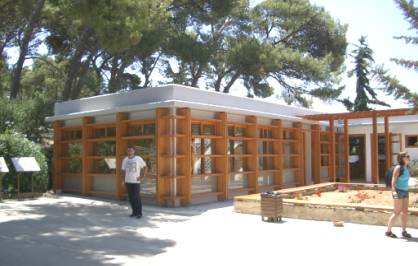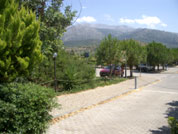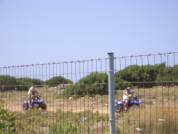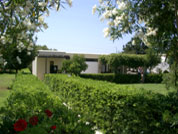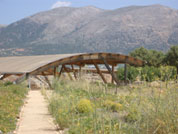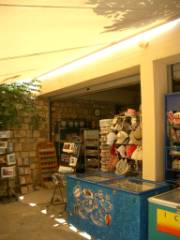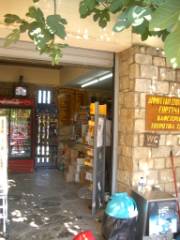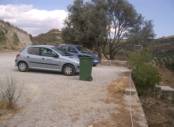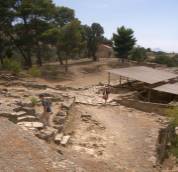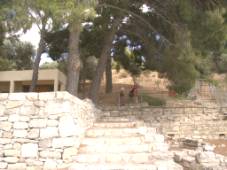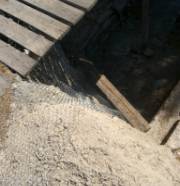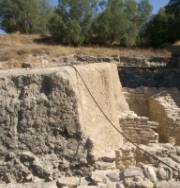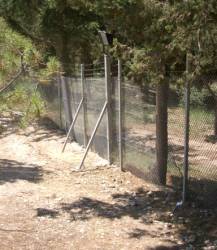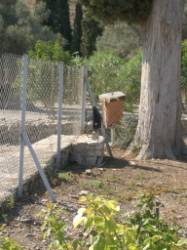2005 Report
Download this document.
Related Documents
2015 Plan Update
1998 Plan
Conditions Re-survey & Update Report October 2005
This is a follow-up report to the 05 March 1998 Conservation Plan by James C. Stratis for the Kommos Archaeological Park.IntroductionThis report intends to summarize the analysis of a comparative review on site conditions at the Kommos Site and other archaeological sites, undertaken on Crete from 29 June through 04 July. It also summarizes a series of meetings The 2005 plan drew directly from the 05 March 1998 Development and Conservation Plan, a collaboration between the author and Joseph W. Shaw undertaken on site during the summer of 1997, with review and input from Martin Schmidt and Clairy Palyvou. The five principal components of the 1998 plan are:
The 2005 Plan called for a re-evaluation of these components and set out a series of action steps and a general outline of budget line item cost, based on unit measures. Key participants with professional service associations for sites that form contextual and geographic association to Kommos continued to inform the results of this year’s re-evaluation. Index: Notes on Comparable Cretan Archaeological SitesComparisonsKommos PlanI.a.) Well and Sump Pump and/or roof
II. Wind Control / Aeolian Sand Deposition
III. Scarp Reinforcement and Ancient Wall Stabilization
IV. Site Access and Visitation
|
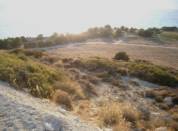 1.slope N.E. of the Kommos site 2005 1.slope N.E. of the Kommos site 2005 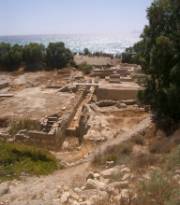 2. Kommos 2005 Southern Area view west June 2005 2. Kommos 2005 Southern Area view west June 2005 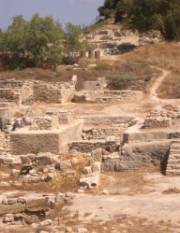 3. Kommos 2005 Southern Area view north June 2005 3. Kommos 2005 Southern Area view north June 2005
|
Knossos, CreteAndreas Michelakakis – Retail Store Manager Conservation issues I and II are, to a certain extent, a consequence to the current, relatively undeveloped natural and geographic environment around Kommos. The site has been mostly abandoned after the Roman occupation. Currently the area is still unoccupied and at the bottom of a slope adjacent to the coastal beach, befitting an ancient port function and context. In contrast Knossos is located on a knoll appropriately sited for its administrative, religious and governmental functions. The drainage – alluvium deposition problem for Kommos is naturally abated at Knossos by that site’s topography, by the manner in which the initial A. Evans excavation took place, by interventions from past treatments and the engineering associated with the modern road. Conditions at Knossos for conservation issue III involving open excavation trenches visible at Knossos are protected by roof covers of simple wooden poles with grape arbors or steel pole roof assembles. There are places where the excavation trench walls appear to have sufficient strength of binder to appear as natural earth. There are other scarps similar to Kommos with stone masonry reinforcement. Development for public access is issue IV and the Knossos site has had significant improvements made to its visitor facilities since the 1997 review of conditions. The retail store manager disagrees with the design of the entrance location at the inner corner of his new facility. Plant beds were poorly cared for, many of the original plantings have expired. The roof top overview was closed off to the public and the portions of the new building intended as dining area (IVd/ Kommos) would not be in operation until August. Michelakakis further believes that the warm and natural material of the wooden solar screening elements (?) compromise or reduce the functionality of the storefront to entice the visitor to the retail environment’s interior.
The 1996 C. Palyvou walkways and guard railings appeared to be in good condition. The appropriateness of walkways such as The availability of statistical data for the site visitation, (a measure of wear) according to C. Palyvou, is mired in an inefficient bureaucracy centered on the mainland in Athens. It is the life cycle wear on the Palyvou timber – metal system that is loosely substantiated as reasonable by the resurvey. A lack of adequate funding for maintenance was acknowledged by all those interviewed. Life cycle and low maintenance must continue as critical design criteria as the plans are evolved. The visual character of the Palyvou walkway system design has potential beneficial thematic design continuity at Minoan Crete sites. There are metal and wood guardrails with wood and stabilized soil walkways, which serve to reduce wear to the exposed archaeological finds. These partially directed the flow of visitor traffic management and yet there are many places where the visitor can get off the path and retreat to some shade and respite from the other tourists. There are stone benches throughout amidst shade trees. Many of the walkways are post-mounted ramp systems, with slopes accommodating the mobility impaired. These elevated walkways also serve to provide overviews of the larger archaeological and environmental contexts. Brochure, map and booklet orientation to the site has been supplemented with the installation of steel stands holding interpretive signage in both Greek and English. The chain link perimeter fence is supplemented with a barbed wire crest and there is security lighting. Other site amenities include pole mounted waste receptacles. Action steps indicated in the 14 June Plan that were intended for the site visit at Knossos 1.b.1 involved interviewing site management personnel, but they were not located on site. Decisions regarding scope of work, budget and contracting were said by site administration officials to be made in Athens. It was suggested that further inquiry could be made at the Heraklion Archaeology Museum. The Proceedings publication “Conservation of Archaeological Sites in the Mediterranean Region by the Getty Conservation Institute” specifically addresses the Knossos site by John K. Papadopoulos. This publication should be recognized and added to the bibliography particularly for anticipated future Getty grant applications. The conclusions of the Papadopoulos paper for Knossos are also very applicable for Kommos. “ Although the scholarly work at Knossos, including long list of prestigious publications, has been mainly carried out by members of a foreign school, the direct responsibility for conservation and maintenance has fallen since 1951 on the shoulders of a national authority, the Greek Archaeological Service. This history raises the issue of the role currently played, or to be played, by foreign institutions in the protection of the cultural resources of a host nation.” |
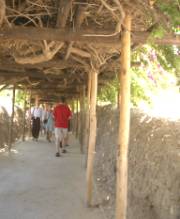 4. Knossos entrance walkway 4. Knossos entrance walkway 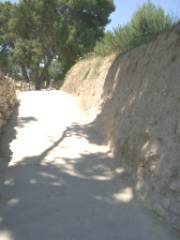 5. Knossos scarp walls 5. Knossos scarp walls 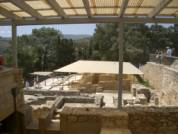 6. Knossos reinforced scarps and steel framed roofs of transparent panels 6. Knossos reinforced scarps and steel framed roofs of transparent panels 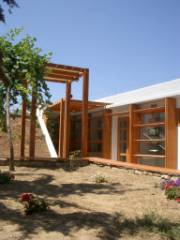 7. Knossos planting area, food service & dining room 7. Knossos planting area, food service & dining room 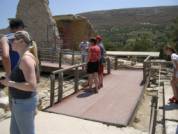 9. Knossos steel & wood ramp walkway 9. Knossos steel & wood ramp walkway  10. Knossos steel & wood walkway 10. Knossos steel & wood walkway 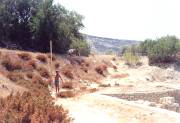 11. Kommos south scarp below overlook southern area 1997 11. Kommos south scarp below overlook southern area 1997 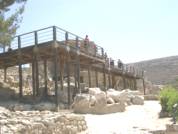 12. Knossos steel & wood walkway 12. Knossos steel & wood walkway 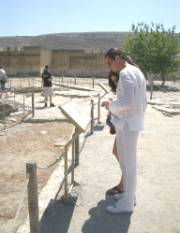 13. Knossos interpretive signage 13. Knossos interpretive signage 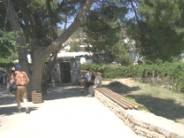 14. Wood boards seating atop a 14. Wood boards seating atop astonewall provide rest stop comfort 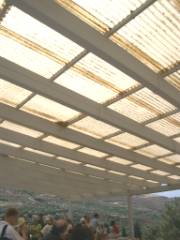 15. Pole, beam & panel roofs 15. Pole, beam & panel roofs
|
Mallia, CreteIsabelle Bradfer-Burdet – Archaeologist Martin Schmid – French School Conservation Architect Drainage controlKommos treatment Ib, at Mallia is achieved to an impressive extent by the multiple roof structures designed by Martin Schmid, which protect the fragile earthen brick walls. Like Knossos, there is no on-site staff that manage capital construction or controlled maintenance at Mallia. The roofs appear to be in fair condition as compared to their condition in 1997. The portions of the laminated wood that extend beyond the roof are in need of topical treatment. The uppermost face of the beams are capped in painted metal. The site is relatively flat and close to the north sea coast. Positive grading appears to adequately control rain runoff. Kommos treatment Ic curb/ gutter or lined swale construction has not occurred at the adjacent access road which leads to a beach similar to the adjacent tourist recreation use at Kommos. Unlike Kommos the aeolian deposition was not evident; treatment II is not apparently needed at Mallia. Given the flatness of the site and the absence of other post Minoan settlement the layers of occupation exposed by the excavation are also not an issue. Scarp or retaining wall reinforcement (Kommos treatment III) did not appear to be a significant conservation issue at Mallia either. Orientation and Access control is Kommos conservation issue IVa. Mallia orientation and access is relatively new; it is well planned and implemented. There are ample asphalt paved areas off the highway for automobiles, motorcycles and buses. Walkways of stabilized soil are straight with board framed edges; they appear in good condition. The metal wire perimeter fence is surrounded by recreating families, often on noisy rental all terrain vehicles.
A white, stuccoed modern building that provides retail sale items, restrooms and medical first aid (Kommos Issue IVb) is also supplemented with rooms with some archaeological orientations and interpretive display.
IVc – viewing areas are primarily from the perimeter of the low walled exposed ruins. There is, however, a superb bridge suspended from the arches of one of the roof structures. This allows the visitor to walk over and look down on the myriad of intersecting walls and affords a vantage point to comprehend the room assemblies. This is the inspiration for the bridge that should span the upper hillside excavation at Kommos. Peripteron snack service IVd – There may be some accommodation within the Mallia site, however, the author visited the site after it had closed and has not researched the availability of such an amenity further. Close by at the beach and again similar to the Kommos site, there is a small private café adding to the recreational experience by providing access to the service conveniences and increasing the enticement to stay longer. It is an important archaeological park management consideration to keep the visitor refreshed, comfortable and rested, allowing opportunity for education in the archaeological discovery and cultural heritage of the island. The Kommos plan, section V, addresses the potential for additional site analysis and archaeological investigation. The Mallia site continues to be excavated and the co-interaction with interpretation for tourist does not appear to be a problem. M. Schmid advocated a minimalist guide rope border for Kommos when he visited the site in 1997. His liberal approach is well represented at Mallia. |
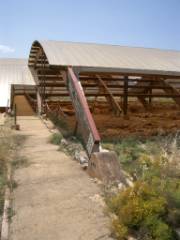 16. Mallia laminated wood arch & Poly-Carbonite roof panels 16. Mallia laminated wood arch & Poly-Carbonite roof panels 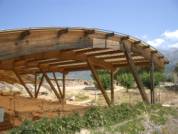 17. slight earthen berms form perimeters of positive drainage 17. slight earthen berms form perimeters of positive drainage 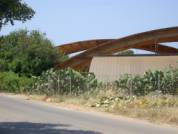 18. Mallia non guttered road adjacent to the archaeological park 18. Mallia non guttered road adjacent to the archaeological park 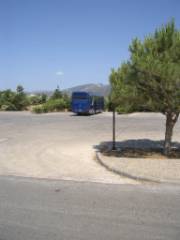 19. Mallia bus parking 19. Mallia bus parking 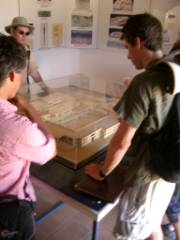 22. Mallia visitor orientation exhibit 22. Mallia visitor orientation exhibit 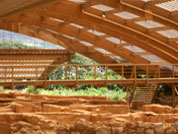 25. Mallia suspended bridge over excavation 25. Mallia suspended bridge over excavation 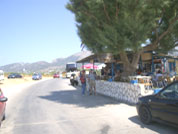 26. Mallia beach café 26. Mallia beach café 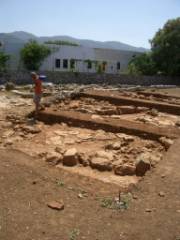 27 Mallia excavation trenches 27 Mallia excavation trenches
|
Gortyn, CreteGeorge Lazanakis – construction foreman Maria Englasiou – archaeologist Theodosis Zacharos – project architect/Crete Ephor’s office The excavations at Gortyn are not sheltered; the post Minoan period structures are open to the elements. Drainage control (I.) appeared to be well established and managed. Aeolian deposition (II.) and scarp or ancient walls appear to be adequately stable at this inland site. There is much to learn regarding site access and visitation from Gortyn. The access road is a busy one; the parking for the site is not separated from it. The unloading and loading of tour bus excursions has resulted in a recent visitor fatality, which brought the poor design to the forefront of funding priority for the K.A.S authority in Athens. The entry to the site will be realigned off the highway and there was construction occurring to replace a new entry building. Construction foreman George Lazanakis and archaeologist Maria Englasiou were affiliated with the local Ephor. They claimed to not know and were unable to address any budget costs or unit cost beyond a guess of 60 Euros/ sq. meter. They directed the author to the architect at the Crete Ephor’s office in Heraklion. The existing entry building served as a model for the Kommos proposal within the plan developed in 1997. The replacement building designed by Theodosis Zacharos at the Crete Ephor’s office in Heraklion, abides by the same design material, form and character design parameters, as the existing smaller structure. Zacharos agreed to meet this author, reviewed the 1998 Kommos Plan and the 2005 Action Plan and suggested that the budget action steps were not worth pursuing at this time. In fact he did not know the budget for the Gortyn entry building and he suggested advancing the architectural design from schematic to design development or even construction documents. He did not understand why the K.A.S. did not respond to the proposal put forward by the previous Ephor Alexandra Karetsou. Architect Zacharos advocated meeting with the new Ephor E.Gramatikaki soon, to review the 1998 plan with her. This was reported back to Professors Joseph and Maria Shaw who had intended to meet with her later in July. Paving stones set in concrete comprised the sidewalk off of the parking area and extend through the painted steel gates. The paved and lighted forecourt or platea as it is referred to in the Kommos plan (Kommos IVa), leads to a flat roofed modern steel reinforced concrete, artifact display building. There is a peripteron (Kommos IVd) adjacent to the display building that is also clad in the stone limestone masonry units maintaining design continuity and site character with the entry building.
Steel chain link fence supported on steel posts secures the perimeter of the site with grade, mounted lighting. Stone retaining wall / benches and wooden & plastic trash receptacles are also present on the site. Awnings mounted on some of the buildings and trees provide shade from the sun. The archaeological also park contains various decorative planting beds. |
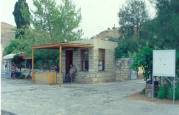 27 Gortyn entrance bldg. July 1997 27 Gortyn entrance bldg. July 1997 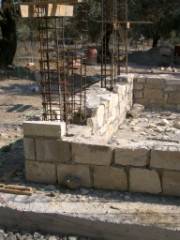 28 Gortyn new entry bldg. June 2005 28 Gortyn new entry bldg. June 2005 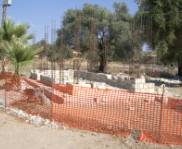 29 Gortyn new entry bldg. June 2005 29 Gortyn new entry bldg. June 2005 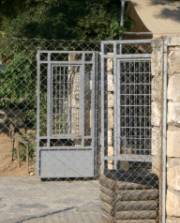 30 Gortyn entry gates June 2005 30 Gortyn entry gates June 2005 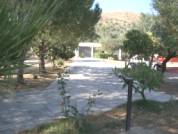 31 Gortyn Plaatea & walkways 06/ 2005 31 Gortyn Plaatea & walkways 06/ 2005 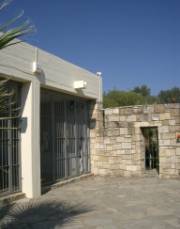 32 Gortyn June 2005 32 Gortyn June 2005 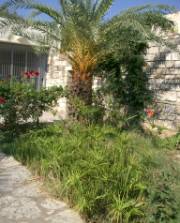 35 Gortyn planting bed June 2005 35 Gortyn planting bed June 2005
|
Phaistos, Crete– entrance attendant – Italian School Archaeologist – Theodosis Zacharos – project oversight architect / Crete ephor Phaistos, the 8400 sq. m. city to which Kommos served as the port harbor town, is situated on Kastri Hill above the Mesara plain. The Kommos plan – section I & II address alluvium & aeolian natural forces on the site, is well sloped from the Palace and several roofed areas are managed with gutters and downspouts. Some of the roofs are the simple painted steel pole and beam type, with corrugated panels similar to those at Knossos. These roofs seemed to best accommodate the design criteria established for Kommos in 1997. There are other awkward roofing systems made of reinforced concrete slab supported by massive concrete piers. As with the other sites visited and surveyed, Gortyn, Mallia and Knossos maintenance administration is through the ephorate in Heraklion and K.A.S. in Athens. There were no capitol construction or maintenance personnel on site. An interview with the architect Zacharos at the Heraklion authority confirmed that the process was slow and involved two tracks. One for plan approval and the other for funding. Plan approval status is discussed above in the Gortyn site review. Regarding funding, he was candid in discussing the financial limitation reality for Kommos at the Ministry of Culture. Contrasted to his caution for Kommos he revealed that a far more complicated replacement roofing system for Phaistos, however, is well developed and nearing the construction phase! Plans have been under development for some years. The plan was briefly shared and Zacharos did agree that he would share it with the author by e-mail. Contact will be reattempted in October to request a copy of the CAD file as discussed in July. The simple materials, easily available and erected at low cost, the continuity of philosophy for subservient presence of interventions on the site, has seemingly turned instead towards a roof of higher technology, increased complications in construction and visual impact. Instead the structure that shields and protects the archaeological building collection becomes a part of the attraction (Bilboa effect) for the visitor. The Kommos Plan intended to build on a common vernacular tradition for archaeological park character on Crete and in the Mesara and continues an intention to abide by conservation principals in the Venice, Ghent and other ICCROM international charters. The brief glimpse of the Phaistos re-roof plan, during the Zacharos interview, indicated a replacement roofing treatment that potentially departs from the concepts or design parameters previously considered for the Kommos site. Threats of the loss of handcraft tradition was a topic of discussion during the 2000 Getty/Loyola Marymount workshop in Corinth, Greece. Handcraft traditions; a component of heritage values were acknowledged by the workshop participants to be in flux and the Phaistos roof may represent a shift in values, as they relate to the question: What does an archaeological park look like? Park benches, trash receptacles, site lighting and other amenities should not be static in their specification of materials and visual character either, but they, like protective shelters, must remain respectful of the designated place and the characteristics that define its significance. The high styled archaeological roof intervention at the desert location of Casa Grande, Arizona, USA or the competitive “come look at me” housing of the Guggenheim museum collection in the historic context of Bilboa, Spain, is too grandiose of a statement for the Minoan nature/ mother earth loving, former builders of this sacred isolated site and the natural pristine coast of the Mesara. |
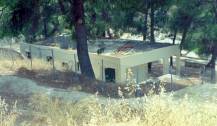 36. Phaistos Kastri Hill July 2005 36. Phaistos Kastri Hill July 2005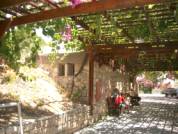 37. Phaistos entrance bldg. & trellis 2005 37. Phaistos entrance bldg. & trellis 2005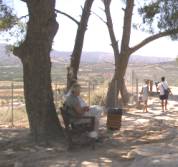 38. Phaistos shelters bad & good 1997 38. Phaistos shelters bad & good 1997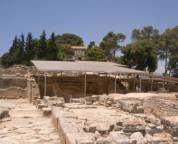 39. Phaistos low impact shelter 2005 39. Phaistos low impact shelter 2005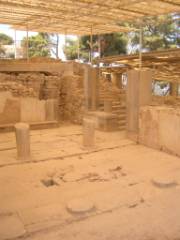 40. Phaistos protective roof: A better prototype for Kommos? 2005 40. Phaistos protective roof: A better prototype for Kommos? 2005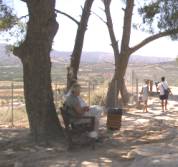 41. Phaistos security fence /amenities July 2005 41. Phaistos security fence /amenities July 2005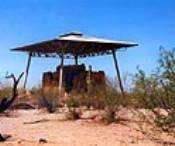 42. Casa Grande, USA shelter 42. Casa Grande, USA shelter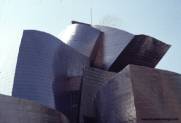 43. Guggenheim Museum Spain 43. Guggenheim Museum Spain
|
Hagia Triada, CreteArriving at Hagia Triada along the same ridge from Phaistos is an anti-climax. The site is modestly marked and the parking area is an extension of the road, representing a similar tragic risk as that previously found at Gortyn. The primary civil engineering design issue at both sites is bus pull-off from the road. The Kommos proposal calls for a pedestrian separation in the form of a planting barrier, similar to what is found at Mallia (photo. 19) or at Phaistos. Pedestrians disembarked from their transport should safely and readily know where to enter the site.
Mobility impaired, disabled, young and old alike benefit in safety and comfort and ultimately in an enhanced visitor experience when hand and guard rails are planned and implemented in an appropriate sensitive manner. Treated natural soil walkways soften the visual and textural impact of the improvement.
The excavation shelters’ steel post are embedded in concrete one of which is inscribed with the date 1975. In 30 years, how many times has the steel been painted? Maintenance will extend the useful life of the shelter; it is sorely lacking here. There are no answers on site but there were 2 cheerful ambassadors prepared to greet the visitor. Corrugated, fiberglass, translucent panels at low slope, parallel to the grade; affixed to painted steel poles embedded in concrete ballast foundations represent a model roof similar to that evident at Phaistos and Knossos. The balance between visitor safety and purposeful reduction of visual impact of the exposed archaeology’s ruins is tenuous, and requires a delicate intervention. For it is the Hagia Triada & Kommos remains, combined with the Mesara and the Mediterranean Sea, that should continue to evoke wonder and respect, for a distinct place and the Minoan culture and people, whose ancestors still derive their living from these natural and cultural resources.
|
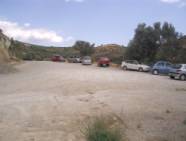 44. Hagia Triada vehicle pull off 44. Hagia Triada vehicle pull offJuly 2005 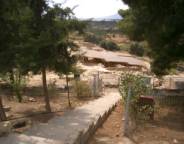 47. Hagia Triada stair entrance July 2005 47. Hagia Triada stair entrance July 2005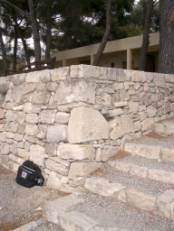 48. Hagia Triada overlook July 2005 48. Hagia Triada overlook July 2005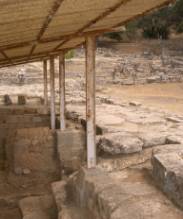 51. Hagia Triada 1985 roof July 2005 51. Hagia Triada 1985 roof July 2005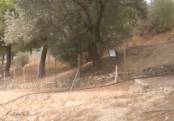 52. Hagia Triada perimeter lighting & fence July 2005 52. Hagia Triada perimeter lighting & fence July 2005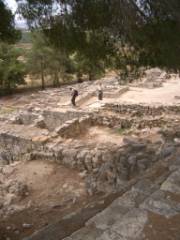 54. Hagia Triada tourist July 2005 54. Hagia Triada tourist July 2005
|
Kommos, CreteJoseph W. Shaw – Excavation Director Costas Nikakis – Conservation Contractor The 1998 plan had received partial review and approval from KAS in Athens and in 2002, Professor Joseph Shaw, excavation Director at Kommos, contracted with Sifas Fasolakis to enact some treatments. In 2003 Shaw was able to contract with Costas Nikakis and experienced conservation treament contractor based in Ayios Nikolaos, Crete to implement a plan by conservation architect Clairy Palyvou. Nikakis and Shaw had worked together at Kato Zacharos years earlier and Palyvou, Shaw and Stratis had walked the site and reviewed the 1998 conservation and development plan in August of 1997. I.a.) Well and Sump Pump and/or RoofIn the east central area of the Minoan road, south of Building V there is an excavation trench prone to filling with rain water and surface drainage in the winter. The 1998 plan considered roofing over the area or installing a sump and drain. The action steps proposed in the June 2005 plan called for local contractor collaboration and the excavation director to locate and dimension the sump well, sump pump piping length and route to the concrete reinforced daylight delta location. During a June 2005 meeting between J. Shaw and J. Stratis, this plan was abandoned for a reburial option. The reconsideration is based on the limited interpretive benefit over the other two portions of exposed Minoan Road, the important structures adjacent to the road in the locations to the west and east. The remaining west center section of the exposed road is adjacent to what may be considered to be the largest (1m x 3m) single stone orthostate component, (Building T), discovered on the entire Island. The western most section of road is adjacent to Building J, is also a more interesting interpretive area and provides better drainage that that on the excavation’s eastern side. I.b.) Translucent Poly-Carbonite Shed Roof StructuresThe Action Ste outlined in the June 2005 plan was undertaken for in situ conservation through review of protective shelters at the five Cretan sites. The Mallia roofs have weathered surprisingly well, although there is clearly evidence of deferred maintenance through weather darkened deterioration to the wood finish outside of the roof covering. The simple shed roofs installed at Knossos, Phaistos and Hagia Triada are confirmed as the least visually impactive to the site and its beautiful shoreline context. They are the least expensive and are readily installed and maintained. Plans and budget information for the approved replacement roofing for Phaistos site will be requested again in October. However, the expense, character and common vernacular tradition for shelters at Phaistos will have departed from the 1998 Kommos design criteria that sought to draw from an archaeological shelter form, tradition and philosophy, that produced an easily recognized cultural environment of protective stewardship. I.c.) Concrete Lined SwaleImprovements to the road through the town of Pitsidia since 1997, have positively resulted in a earthen bank on the west edge of the beach access road on the eastern side of the site. The long term solution of a maintainable drainage curb, similar to that on the highway to Mallia from Heraklion is still necessary. I.d.) Regrade Non Compatible Modern Stone LiningIn conversations with the Ephor of Crete and her office subsequent to the 1998 Conservation and Development Plan, the drainage improvement to this area will now been re-addressed within a separate plan for the southern area adjacent to the archaeological park. This beach recreation park was schematically illustrated in figures 003 and 023 within the 1998 plan after conversations with the local town mayor. I.e.) Outlet ProtectionThe origin of the unmanaged drainage evident in photograph 60 -62 is no longer addressed in this Kommos updated conservation treatment plan. This will continue to be discussed with the local town of Pitsidia, but the treatment will be removed from the Scope of work and budget for this plan. Consultation with numerous professionals indicated in the attached meeting notes altered the June 2005 Action Steps, eliminating all the budget development steps. II.a.) Natural Wind FenceIn 2000 ck? a water line was brought down from the town of Pitsidia municipal supply to the east of the site. Excavation Director Joseph Shaw was able to have local workmen plant indigenous tamarisk trees inside the southern fence line. II.b.) Reinforced Synthetic Start-up ScreenAs an alternative to the II.b. design – a synthetic start –up screen west and outside of the perimeter fence, local workmen under the finance and direction of the University of Toronto’s J. Shaw, erected a low cost natural screen of branches against portions of the existing southern area’s west fence. The aeolian deposition has been significantly blocked by this successful, less technological and expensive treatment, than that originally planned. Note comparison photographs #107 attached. Many of the palm fronds have dried, become brittle and have deteriorated to the extent that the entire length of approximately 30 m. should now be replaced. The deposition now occurs on the west side of the fence, unfortunately lowering its effectiveness as a perimeter barrier against the public. III.a.) Replacement Reinforced Cementitious Scarp Coverings with Integrated Indigenous PlantingsThousands of dollars of funding over the last three summers from the University of Toronto through excavation Director J.W. Shaw has provided necessary structural stabilization and the improved visual blending of the scarp walls into the site. A wire screen was placed over the existing scarp wall then reparge coated with more compatible masonry constituents.
III.b.) Supplimental Rock WallsThe integration of plant materials to soften the impact of the excavation on the landscape was a consideration for section IIIa in the March 1998 Conservation Plan. The reformulation of the stucco coating has abated the contrast and has accomplished a similar objective of reducing the presence of the new scarp wall. This plant reintroduction concept, however, is now within the last eight years well represented on the tall eastern retaining wall. IIIc.) Ancient wall StabilizationThe experienced Cretan conservators are removing some of the unstable uppermost course of the ancient wall, removing soil and relaying them square and level. IV.a.) Orientation and Access ControlHeritage tourist orientation is a critical factor for a safe and memorable archaeological park experience. Design and location of certain park amenities must also be planned. The following nine features intend to allow the visitor to know where they are in relation to the entrance and certain artifact features, as well as the amenities for their comfort and enhanced enjoyment. These nine security and orientation amenities must be sufficient in number and situated with the efficient visitor traffic flow in mind. 1. Parking, 2. Gates, 3. Fences, 4. Pathways, 5. Plateas, 6. Lighting, 7. Seating, 8. Trash Receptacles, & 9. Shade. Most orientation and access control were found to be very similar at all 5 sites, with some notable exceptions. V.a.) Parking:Knossos – There are several private lots adjacent to the site. The free parking north of the site is under sized and poorly marked. Mallia – Free paved parking and adequately sized, well paved and engineered with plant screen areas (photo. 19). Gortyn – The free parking was dangerous and is in the process of being relocated and constructed. Phaistos – The free paved parking is separated from the road with a planting strip but the pedestrian crossing is not evident and there is a curve in the road at the entrance site that may produce a hazardous combination. Hagia Triada – The free parking is an extension of the unpaved road, is poorly signed, and without curb and gutter. V.a.) Gates:Knossos – The manned entrance gate at Knossos is nondescript and approached through a covered walkway (photo. 4) and past the new retail store and an older structure that also sells items to the visitor. The back gate above the free parking is part of a steel fence with small sections of masonry wall. It appears as a prior front gate with an abandoned ticket booth. Mallia – The unmanned entrance gate is also arrived at after a brief walk from the parking and is past the ticket building (photo 23). Gortyn – There are two pairs of gates accessing different parts of the site from the entrance ticket building. The painted welded steel gates are adjacent to the entrance ( photos. 27 & 30) and they appear to be the same as those at Hagia Triada. The ticket seller monitors those that pass, entering and exiting, through the gates. The gates are adjacent to the Entry Building (photo. 27) and are flanked by masonry piers. Phaistos – There are guards at the entry gates. This second most visited site has considerable visitor traffic entering and exiting from the same gate. Hagia Triada – The metal gate is unmanned but it is adjacent to the entry building as at Gortyn. V. Fences:The fence around the Kommos site has been bent over in several locations. There has been an increased use at the beach since the 1997 site condition recognizance and the metal wire fence has been regularly breached as is evident at the number of niches where toilet paper is scattered. All the sites’ fences surveyed were metal post and chain link or welded wire mesh variations and appeared undamaged. They all have official staffing presence, on-site. Note – Phaistos photo 41.
IV.a.) 4 Pathways:Knossos – Stabilized soil, stone paving, wood ramps with non-slip synthetic covering, well maintained. There is allowance off the treated walkways, even encouraged through the placement of stairs that descends to grade. (Photos. 4,5,8,9,10 & 80) Mallia – There are diverse pathway types like Knossos, however, particular to Mallia was wood edging on the stabilized soil pathway and a the wood deck bridge in one of the Shelters. (Photos. 16,20 & 24) This is not appropriate for the curved sloped conditions at Kommos. Gortyn – Stone pavers and tamped soil. (Photos.27,30,31,32 & 35) Phaistos – Stone pavers, tamped soil. The sloped entrance is paved in stones that are hazardous as they have become polished with wear. Walkways, depending on their steepness, may be supplemented with hand rails or guardrails. Four of the five sites considered for walkway prototypes for Kommos, were supplemented with railings and care was exercised to place them at stairs and elevated areas (Knossos). The magnificent view of the western Messara remains unencumbered in some places and minimally impacted by perimeter fence in others. Restraint for the Kommos pathway and guard rails will take heed of the prototype treatments at these other sites. (Photos. 39,41 & 81) Hagia Triada – Sidewalk from the parking area is non-existent, the entrance stairway is too steep without interim landings and too narrow for ascending and descending traffic and without handrail. There is little in the way of pathway once inside the site. Hagia Triada in general suffers from the least amount of staffing and visitor amenities while Knossos has the most developed. This is probably due to visitation numbers and the priorities established at the central management at the Ministry of Culture. The walkways at Hagia Triada in 1997 or in 2005 demonstrates little prototype to benefit the Kommos Park development planning. (Photos. 46,47,48 & 54) IV.a.5. PlateasThe March 1998 Kommos plan indicates two Plateas one outside at the entry building and the other inside the entry gates. They both serve as a place for visitors to gather, become orientated to the route of travel through the site or to await commencement of organized tours. This type of place was observed at Knossos, Phaistos and at Hagia Triada. Knossos appeared undersized in area, although offered several linear meters of curiously unused wooden bench seating. Hagia Triada was situated at a considerable drop (2 m.) off of a modern retaining wall and provided three wooden benches with a view over the site, these benches can accommodate 9 – 12 visitors. IV.a.6.) LightingPerimeter lighting was observed and photographed at Knossos, Gortyn and Hagia Triada. Walkway lighting, too, was recorded at Mallia, Gortyn and Phaistos. Gortyn had fixtures on the corners of its artifact display and food service buildings. All five sites may have lighting installed; this survey was not thorough enough to document all lighting conditions. As with many other survey questions the personnel were usually not at the site to complete the questionnaire. Should Kommos be developed for visitation some lighting at the southern Platea, the eastern walkway and the parking area may be considered. Security lighting for the perimeter or within the site has not been considered at this phase of design. (Photos 31,52 & 79) IV.a.7.) SeatingSeating that was available for Park visitors besides that found in the plateas and food service areas were documented at Knossos, Gortyn, and Phaistos. A fairly level area to the side of the visitor traffic to the archaeological features and within shade, are important locational criteria. Seating materials were constructed of stone, metal wire and wood. (photos. 41, 85 & 86) IV.a.8.) Trash ReceptaclesIf receptacles are present they will be used and they require regular service. These amenities were either pre-fabricated and made of plastic mounted on steel post or made of wooden surrounds for steel, standard metal, trash cans inserts. How often along the walkways or how many within the park are dependent to some extent on the number of visitors and what is readily available for their consumption. (photos. 30,41,46 & 78) IV.a.9.) ShadeTrees provided almost all the shade and as stated above are typically benefiting the placement of rest area seating. A need for some respite from the Mediterranean sun during the tourist season and potential Park operations, have produced other shading devises at the five Parks surveyed in 2005. These include fabric awnings found attached to structures at Gortyn and a grape arbor or trellis. A spectacular arbor from Kommos is visible in photo 4. The Kommos Development Plan includes both of these man made comfort amenities. (photos. 4,7,8,27,37,41,48,85,86 & 87) IV.b.) Sales, Restrooms and Medical First AidAll five of the sites studied for the Kommos prototype conservation and development components included a building that housed the gate ticket sales which most often combined a security function, toilets and a space for the sale of water, snacks, maps, booklets, etc. The character of these buildings was surprisingly similar and comprises a local vernacular tradition. This tradition is respected and represented in the twin entry building proposed for Kommos. Mallia and the new buildings at Knossos departed from the cladding and fenestration patterning more than the entrance buildings at Phaistos and Gortyn. Those sites also have dissimilar architecture such as the food service building at Phaistos and the Gortyn artifact display building. These depart from the model stone masonry and concrete bond beam ticket sales buildings at Phaistos and Gortyn that directly influenced the Kommos entry buildings character. (photos. 7,8,23,32,45 & 83) IV.c.) Viewing Areas for archaeological, geo-physical and natural history interpretationThe north south sloped Kommos site with the ever-present Libyan Seacoast and beach on the west offers a unique and remarkable distinction from the other sites. The Entry Platea and the Central Hillside Platea provide areas to pause and reflect on the three excavated areas and their relationship to the topography and the sea. There are other places where specific vantages can be emphasized. The overlook between the Tamarisk/ Almiriki trees to the south and above the stoa and kiln features is planned as a (stone?) paved viewing area from which the site in its entirety ascends the slope to the north, beyond the complex strata of the southern area. A wooden deck walkway with steel rails within a wooden post and handrail system can support the mounting of plaques (photos 8 & 13) containing a variety of interpretive material. This ramp walkway is envisioned as similar to those designed by C. Palvou at Knossos. (photos. 9, 10,12,80,89 & 90) Across the Kommos southern area just north and above the Minoan road at the western edge is planned another post mounted viewing area. Here the visitor can look on the road to the sea, at the impressive remains of Building J and back across at the agora and the route of travel across the unique hypothesized set of ship storage structures-building group P. A 130 square meter stabilized soil viewing area at the Central Hillside,will be another area large enough to accommodate tour groups, interpretive materials and amenities indicated in Section IVa. The most spectacular viewing area will be at a bridge that spans the upper Hillside surmounting the crown of the slope and affording an expansive view over the site to the south and the shoreline to west. As at Mallia the primary purpose will be to provide a bird’s eye view of the complex residential floor plan, comprised of a maze of unrecognizable small rooms. The published scholarship will provide the interpretive program with a wealth of material and as with the walkway guardrail, interpretive panels can offer the visitor a range of information. IV.d.) Peripteron (refreshment stand)The tool storage shed has been well maintained and may serve as an upper hillside source for refreshments. A small seating area may serve this back door area to the parking and disabled access to the upper hillside portion of the excavation. V.) Future Excavation AllowanceThe re-survey, analysis and interviews conducted in June –July by J.C. Stratis and the meetings held with various officials by J. W. Shaw have not altered the plan to pursue its approval by the various officials in Heraklion and Athens. Provisions for the transference of the archaeological collection to the eastern Crete organization INSTAP is presently undergoing negotiation. There is renewed response and participation by DAAM that had originally responded with the approval of the C. Palyvou November 2001 conservation plan (section III of the Stratis-Shaw March 1998 plan) and then languished without comment for the other four sections of the plan. The scarp and ancient wall stabilization by C. Nikakis has now been 75% completed and has been funded by the University of Toronto. Conclusions – Next StepsThe action steps centered on Crete as outlined within the Conservation Plan updated 14 June 2005, were largely unattainable. During discussions with J.W. Shaw on 02 July the decision was made to abandon the pump option in Section 1a. Maintenance personnel interviews proved infeasible as a centralized authority in Athens and maintenance management was not present at the five sites re-surveyed. Meetings with the architect Theodosis Zacharos at the office of the Cretan Ephor on 04 July and by the conservation architect Clairy Palyvou at her home in Athens on 06 July resulted in both independently recommending to advance the planning. Zacharos also suggested that we seek approval of the plan from KAS as a separate effort from the approval. Palyvou recommended building on the approval for section III of the plan that she had further developed in 2001. In August of this year Joseph & Maria Shaw received an encouraging letter from DAAM perhaps due to a change in the directorship. Pursuit of funding in order to accomplish the design development phase prior to construction document phase with budget development should also be pursued outside of the Ministry of Culture / European Economic Community. Investigation on the application process for funding from the Getty Conservation Grant Program was commenced by James Stratis in 1996 with Timothy Whalen , Senor Program Officer who in December of 1998 became the Director of the Getty Conservation Institute. In September of 2004 the author attended an invitational International Colloquium, sponsored by the GCI and managed by Leslie Rainer – GCI Senor Program Specialist. Some updated fact finding, by the author in May – July of this year through L. Rainer, led to the GCI’s Francoise Descamps who is in charge of the Hoya de Ceran project in El Salvador. Rainer explained that the GCI was interested in advancing innovations in conservation science involving multi-discipline teams. Descamp’s project is concerned with site management and conservation, participatory and value-driven management planning. There were two individuals in Colorado, Payson Sheets and Anthony Crosby also associated with the Mayan Initiative Project Contact with both Colorado project contacts lead back to F. Descamps at GCI, whose planning products to date are only available in the Spanish language. In an e-mail dated 14 July 2005, after meeting to discuss the project, A. Crosby additionally recommended speaking with Carolina Avilia Castellanos about the Mayan Initiative. Further inquiry into the project has not occurred to date but additional investigation is planned within the next few weeks. L. Rainer had suggested the other Getty grant program outside of the GCI. A search of the internet uncovered the Architectural Conservation Grants program from the Getty Foundation. This seems vaguely possible but specifically states “historic structures” not archaeological ruins stabilization. Other Getty grant opportunities may be more feasible than the GCI program, but it seems planning must be more developed and budgetary figures are necessary. |
 55. Kommos south perimeter road to beach July 2005 55. Kommos south perimeter road to beach July 2005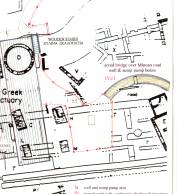 56. infill road- excerpt of figures 004 and 005 section Ia March 1998 56. infill road- excerpt of figures 004 and 005 section Ia March 1998 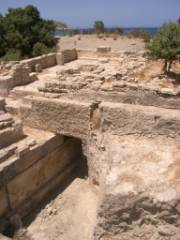 57. Kommos Minoan road & bldg 2005 57. Kommos Minoan road & bldg 2005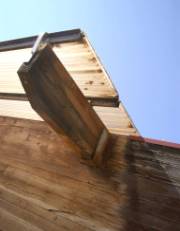 58. Mallia weathered truss July 2005 58. Mallia weathered truss July 2005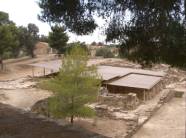 59. Hagia Triada roof assembly June 2005 59. Hagia Triada roof assembly June 2005 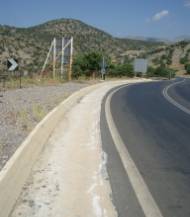 60. Road curb & gutter west of Mallia June 2005 60. Road curb & gutter west of Mallia June 2005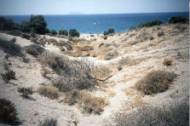 61. natural swale south & east of Kommos August 1997 61. natural swale south & east of Kommos August 1997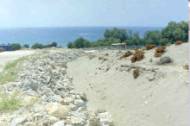 62. tone line trench,south & east of site August 1997 62. tone line trench,south & east of site August 1997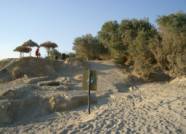 63. Natural east-west down slope drainage south the site. June 2005 63. Natural east-west down slope drainage south the site. June 2005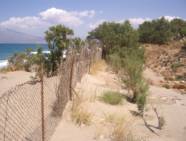 64. new tamarisk trees row and water line inside west fence at southern area 2005 64. new tamarisk trees row and water line inside west fence at southern area 2005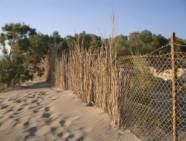 65. west fence with organic reinforcement. June 2005 65. west fence with organic reinforcement. June 2005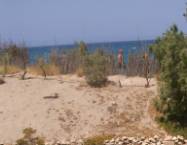 66. west fence @ southern area’s north-west corner June 2005 66. west fence @ southern area’s north-west corner June 2005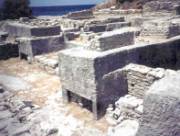 67. Kommos Southern Area Scarp 08/9 67. Kommos Southern Area Scarp 08/9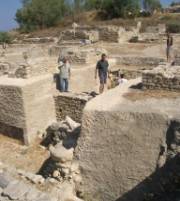 70. Kommos re-consolidation July 2005 70. Kommos re-consolidation July 2005 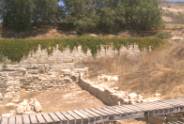 71. Kommos contemporary retaining wall with indigenous plant curtain July 05 71. Kommos contemporary retaining wall with indigenous plant curtain July 05 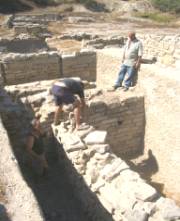 72. Kommos ancient wall stabilization July 2005 72. Kommos ancient wall stabilization July 2005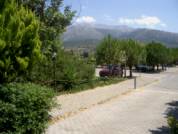 73. Mallia parking lot and sidewalk at patterned entrance June 2005 73. Mallia parking lot and sidewalk at patterned entrance June 2005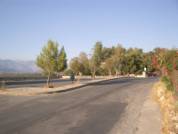 74. Phaistos parking left side of road 05 74. Phaistos parking left side of road 05 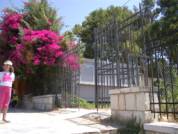 75. Knossos unmanned back gate 06/05 75. Knossos unmanned back gate 06/05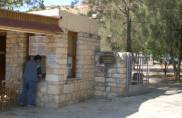 76. Gortyn entrance gate July 2005 76. Gortyn entrance gate July 2005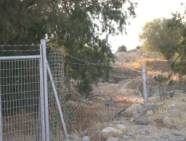 77. Kommos crushed fence at southern west gate June 2005 77. Kommos crushed fence at southern west gate June 2005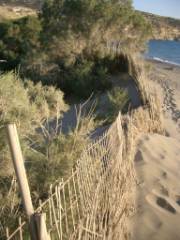 78. Kommos west fence at wind barrier 78. Kommos west fence at wind barrier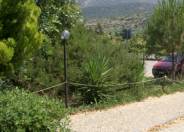 79. Mallia barrier & lighting June 2005 79. Mallia barrier & lighting June 2005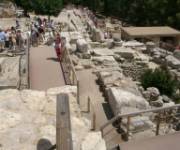 82. Knossos covered ramps June 2005 82. Knossos covered ramps June 2005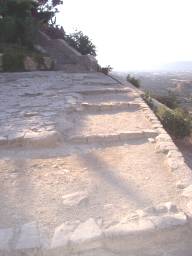 83. Phaistos transition from the upper visitor service area to archaeological site will be difficult for some. July 2005 83. Phaistos transition from the upper visitor service area to archaeological site will be difficult for some. July 2005 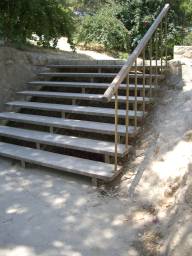 84. Knossos stair & railing June 2005 84. Knossos stair & railing June 2005 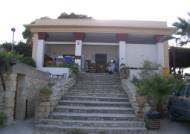 85. Phaistos stairs to the retail shop / food service palace-temple at the top of the Platea. July 2005 85. Phaistos stairs to the retail shop / food service palace-temple at the top of the Platea. July 2005 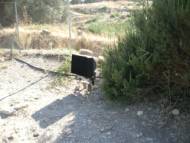 86. Gortyn perimeter lighting June 2005 86. Gortyn perimeter lighting June 2005 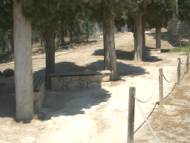 87. Knossos stone & wood benches 06/05 87. Knossos stone & wood benches 06/05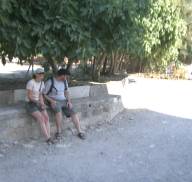 88. Gortyn stone & cement benches 07/05 88. Gortyn stone & cement benches 07/05 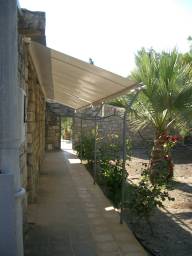 89. Gortyn back of shop retractable awning 89. Gortyn back of shop retractable awning 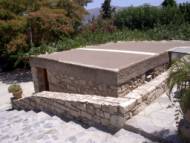 90. Phaistos retail sales building below the shop/food service building July 2005 90. Phaistos retail sales building below the shop/food service building July 2005 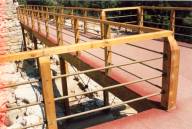 91. Knossos Palvou walkways August 1997 91. Knossos Palvou walkways August 1997 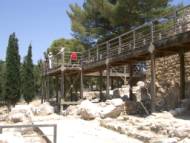 92. Knossos raised walkways June 2005 92. Knossos raised walkways June 2005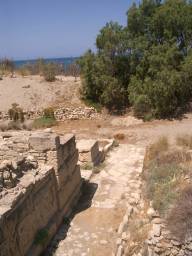 93. Kommos Building J overlook July 2005 93. Kommos Building J overlook July 2005 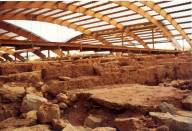 94. Mallia bridge over excavation 06/ 1997 94. Mallia bridge over excavation 06/ 1997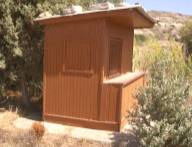 95. Kommos shed/Peripteron July 2005 95. Kommos shed/Peripteron July 2005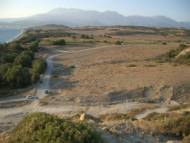 96. Kommos eastern slope June 2005 96. Kommos eastern slope June 2005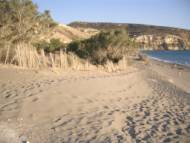 97. western fence @ southern area 06/ 2005 97. western fence @ southern area 06/ 2005 98. Interpretive illustration of the kiln against the agora 98. Interpretive illustration of the kiln against the agora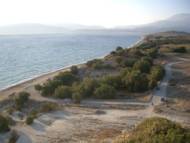 99. Kommos site view north June 2005 99. Kommos site view north June 2005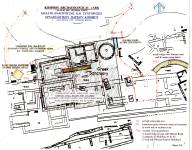 100. Roof plan Greek Temples August 98 100. Roof plan Greek Temples August 98 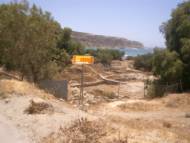
|

